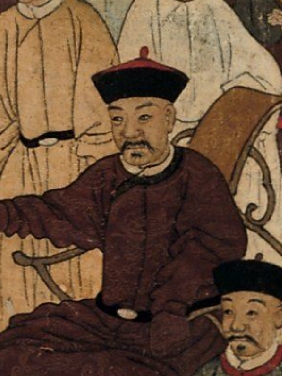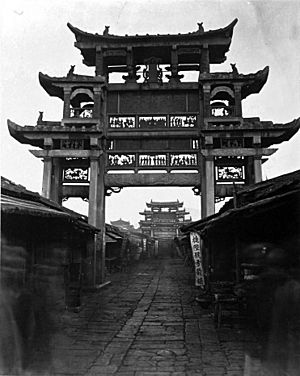Shi Lang facts for kids
Quick facts for kids Shi Lang |
|||||||||||||
|---|---|---|---|---|---|---|---|---|---|---|---|---|---|

Shi Lang in the company of high-ranking officials
|
|||||||||||||
| Chinese | 施琅 | ||||||||||||
|
|||||||||||||
Shi Lang (born in 1621, died in 1696) was a famous Chinese admiral. He was also known as Marquis Jinghai. Shi Lang served two different dynasties: first the Ming dynasty and then the Qing dynasty in the 1600s. He became the main leader of the Qing navy. He helped defeat the forces of Zheng Chenggong's family in the 1660s. Later, in 1683, he led the Qing army to take over the Zheng family's Kingdom of Tungning in Taiwan. After this victory, Shi Lang helped govern parts of Taiwan.
Contents
Early Life and Military Start
Shi Lang was born in 1621 in Jinjiang, Fujian, a place known for important families. From a young age, he studied how to plan and fight wars, especially on the sea. He was also known for being strong and brave in battles. The Kangxi Emperor once said that Shi Lang was a fierce fighter and very good at leading armies.
In the early 1640s, Shi Lang joined the navy of Zheng Zhilong. He became a captain in their fleet. During this time, he had some disagreements with Zheng Zhilong's son, Zheng Chenggong. In 1646, Shi Lang decided to join the Qing dynasty instead. Because of this, Zheng Chenggong sadly killed Shi Lang's father, brother, and son.
Fighting the Zheng Family
The Qing rulers really valued Shi Lang because he knew a lot about naval warfare. He also had many friends and contacts in important trading ports across East Asia. In 1656, he joined Prince Jidu (who was the son of Jirgalang) on a trip to Fujian. There, Shi Lang became an Assistant Brigadier-General.
In 1663, he helped lead a campaign against the Zheng family. He even commanded Dutch ships and their crews to follow up on Qing victories. In 1668, he suggested a plan to remove the last parts of the Ming dynasty from Taiwan and the Pescadores (Penghu). However, his plan was not used at that time. He was then given a special job in the Imperial Bodyguard.
Taking Control of Taiwan
In 1681, after a big rebellion called the Revolt of the Three Feudatories, the Kangxi Emperor needed someone to lead a sea attack on Taiwan. Following advice from Li Guangdi, the emperor chose Shi Lang. Shi Lang insisted on being the only commander, not sharing power with Yao Qisheng, who was the Governor-General of Fujian.
On July 8, 1683, after a lot of planning, Shi Lang led a huge force. He had 300 warships and 20,000 soldiers sailing from Tongshan, Fujian. Just a few days later, on July 16–17, he won a major battle. He defeated the Zheng family's main naval leader, Liu Guoxuan, near the Pescadores.
On September 5, Shi Lang received an offer from Zheng Keshuang to give up. Then, on October 3, Shi Lang arrived in Taiwan. He officially accepted the surrender of Liu Guoxuan and Zheng Keshuang.
After this successful campaign, Shi Lang went back to the Chinese mainland. He worked hard to convince the Kangxi Emperor that Taiwan should become a part of China. Some people in the Qing government did not want to take Taiwan. They thought it would cost too much money to keep. But the Kangxi Emperor agreed with Shi Lang. In 1684, Taiwan was divided into three areas and became a part of Fujian province.
Shi Lang was given the special title "General Who Maintains Peace on the Seas." He also received the important hereditary rank of marquis. He was even allowed to wear an honorary peacock feather, which was a great honor. Shi Lang continued to work in Fujian. He helped make rules that aimed to keep Taiwan separate from the rest of the Qing Empire. For example, people from coastal areas were not allowed to trade with Taiwan. People from inland areas could not bring their families, which made it hard for them to settle there permanently.
Even though he was later accused of being too proud, the Kangxi Emperor met Shi Lang in Beijing in 1688. The emperor allowed him to sit in his presence, showing he still trusted him. Shi Lang returned to Fujian and stayed in his job until he died in 1696.
Shi Lang's Impact

After he died, Shi Lang was given the special name "Xiangzhuang." He also received the title of Junior Tutor to the Heir Apparent. In 1732, his name was placed in the Temple of Eminent Statesmen for people to honor him. One of his sons became a respected admiral, and another became an important government official. The Shi family was given a special right to be buried in their family cemetery in Jinjiang, Fujian. This was different from other Bannermen, who usually had to be buried in Banner lands.
Shi Lang is famous for his military successes. However, he is still a figure that people discuss in China today. He is sometimes seen as someone who left the Ming loyalist cause to join the Qing. Because he changed sides, his achievements have sometimes been downplayed by governments in both Taiwan and China. In Taiwan, he is remembered as a conqueror.
See also
 In Spanish: Shi Lang para niños
In Spanish: Shi Lang para niños

